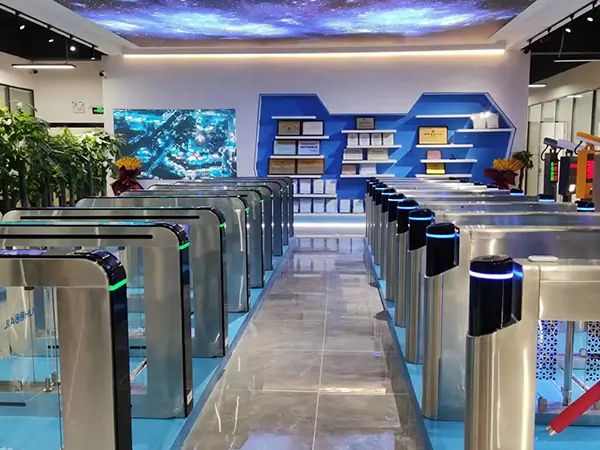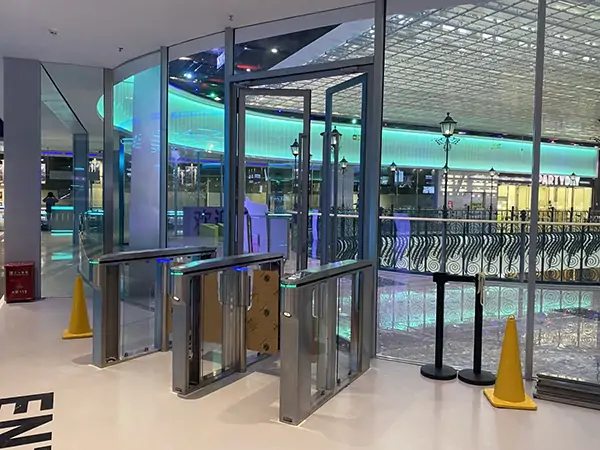What is the subway turnstile?
In public transportation facilities like subway and other subways, a turnstile is a feature that is employed in controlling the passage of individuals securely and with a smooth flow while admitting only a single person at a time in order to forestall unauthorized passage and promote neatness. These devices are often equipped with technologies such as card readers or QR code readers in order to provide more convenient and easier ticketing processes for commuters. Devices applied in managing the inflow and outflow of individuals at subway entrances and exits through processes such as card payments. Using QR codes and facial recognition for payments plays a crucial role in efficiently handling ticketing charges.
Working principle
The way a subway turnstile operates includes a mix of parts and sophisticated electronic systems at play in sync with each other. When someone gets closer to the turnstile with a ticket or payment option (like a metro card or QR code on their phone), the system checks the details using scanners or readers built into it. After confirming the validation of the credentials, the turnstile briefly unlocks to let a single person pass through.

One good example of how KARSUN showcases this principle is through its cutting-edge product designs. The JS-TD6301-21-Flap Barrier Turnstile Gate stands out for being both space-efficient and budget-friendly while guaranteeing seamless operation. Making it a perfect choice for busy areas with heavy foot traffic, where managing large crowds efficiently is essential.
Furthermore, these gadgets commonly come with safety measures to avoid mishaps or misapplication. For instance, sensors can identify if there are individuals trying to enter at the same time or if someone is attempting unauthorized entry. In these scenarios, the system sets off an alarm and secures the gate temporarily.
Customized subway turnstile
Every subway system worldwide has needs and customization is key to meeting them effectively. KARSUN is known for offering solutions that match the operational requirements and design preferences of each system.
The JS-Y011-Flap Barrier Turnstile Gate is an example of innovation in access control systems. It provides a sturdy option suitable for busy locations by ensuring effortless usage and harmonious integration with contemporary architectural designs.
The JS-YZ017-Flap Barrier Turnstile Gate offers a blend of style and utility through its customized features that cater to both practicality and visual attractiveness in metro stations with its sleek design and quiet performance.

KARSUN’s disposal are models with diverse characteristics, different chassis sizes and shapes as well as operational mechanisms are available for clients to choose from based on their requirements. Whether the aim is to regulate the flow of crowds during busy periods or improve security at entry points, their tailor-made subway turnstiles consistently provide top-notch performance.
Functions of Subway Turnstile
Ticket Checking Function
Subway gates are crucial for validating tickets and allowing authorized passengers to enter the subway system effectively. These gates incorporate technologies like card scanners QR code readers and even facial recognition systems. Various crowd management features at subway entry and exit points, such as card payments and QR code scanning, help streamline ticket fee collection efficiently. This smooth integration not only enables swift access but also minimizes the necessity for manual ticket checks thereby, enhancing overall operational efficiency.
Safety Protection Function
Safety holds importance in subway networks as turnstiles encompass safety features to safeguard commuters. Embedded sensors in the turnstiles identify entries or instances of multiple individuals entering simultaneously. Should an individual try to circumvent the system or follow closely behind another passenger unlawfully the turnstile will activate an alarm. Initiate a temporary lock for security measures. Furthermore, these devices commonly incorporate pinch mechanisms to avert mishaps during their operation.
Recording Function
Subway turnstiles nowadays are created to gather and save information about how passengers move through them efficiently manage their service operations and enhance the travel experience for commuters by analyzing data collected from each transaction made through card swipes or QR code scans.
The Subway Turnstile Has Multiple Modes of Passage Selection Functions
For various passage requirements, it can be set up in one-way card swiping or free passage two-way card swiping, or set up the metro turnstile gate into a normally opened mode in a special period of time for the convenience of a large-scale number of people walking through.
Emergency Response Function
During emergencies, like fires or power failures subway gates are programmed to open. This allows passengers to exit swiftly without any delays. The emergency response feature is a safety element that highlights the significance of incorporating smart technology into public transportation systems.
Provide Accessible Passage
Subway turnstiles also aim to provide accessibility for all passengers by incorporating features to cater to individuals with disabilities, such as lanes and specialized gates for wheelchairs and strollers.
Advantages of Subway Turnstile
Preventing Terrorist Attacks
Subway stations face security risks, due to the number of people passing through them daily. Gates serve as a barrier by managing entry points and overseeing the movement of passengers. Modern turnstiles linked with monitoring systems can detect behavior or unauthorized entries promptly improving security measures overall.
Improve Security
By allowing only individuals with tickets or credentials to pass through them, subway turnstiles play a crucial role in enhancing security within underground train networks. Innovative devices such as the JS-YZ018-Flap Barrier Turnstile Gate are specifically engineered to efficiently manage entry points. Their architecture and advanced features bar unauthorized users and provide seamless experience to approved travelers.

Improve Operational Efficiency
The subway turnstile can automatically read passengers and ticketing information and, therefore, save the time and cost of manual ticket checking and facilitate the convenience and efficiency of subway operation.
Data Management
Modern subway turnstiles have the capability to gather data on passengers’ travel behaviors which helps metro operators in improving train timetables and adjusting station staff levels, according to demand patterns while also facilitating expansion planning based on these insights. In addition, accurate fare collection is guaranteed through automated methods, which helps to monitor revenue.
Composition of Subway Turnstile
Chassis
The base of a subway turnstile is crucial for its strength and stability. Is built to last using top-notch materials such as stainless steel 304 to endure the rigors of busy locations day in and day out without fail. One example is the JS-BZ001-Swing Gate with a stainless steel 304 frame that can brave any weather condition – perfect for indoor or outdoor settings. Inside the chassis lie the mechanics and electronics, shielded against moisture and dust for lasting performance in various environments.

Mechanism
The mechanism is the part that allows the turnstiles blocking the wings or arms to move physically. It guarantees functioning by managing the locking and unlocking procedure upon detection of a valid ticket or payment method. Sophisticated mechanisms are created for operation to improve the passenger’s journey.
Control System
The system that regulates access combines both hardware and software to control access permissions, using information from sensors and payment systems to decide whether entry should be allowed or restricted. Modern control systems come equipped with algorithms to tackle challenging situations, like high traffic during peak hours or emergencies.
Sensors
Subway turnstiles benefit greatly from the role sensors play in improving their performance and safety measures. These sensors are responsible for identifying any access attempts or instances of multiple entries and detecting obstructions in the walkway. In response to situations detected by these sensors. Alarms are triggered or the turnstile is temporarily locked to deter misuse. For example, products are equipped with safety features that utilize sensors to guarantee secure operations. Furthermore, sensors aid in conserving energy by activating components when required.
Blocking Wing
The barrier on the side of the turnstile acts as an obstruction to regulate how people move through it by either using a flap or other mechanisms, like a sliding panel or rotating arm depending on the specific design of the turnstile model being used.
Payment System
Subway turnstiles are equipped with payment systems that cater to various payment methods like card readers, QR code scanners, coin slots and even facial recognition technology. To regulate the flow of people at subway entrances and exits they have crowd control features. These systems help facilitate passenger movement by allowing fast and secure transactions.
Advanced Technology in KARSUN’s Subway Turnstiles
Turnstiles in subway stations are fitted with sensors that offer live monitoring features, boosting security by identifying unauthorized entry attempts and unusual passenger actions efficiently. An immediate response to risks or operational problems is facilitated through systems of real-time surveillance. Robustness is prioritized in product design by KARSUN, through the employment of high-quality materials such as stainless steel 304. Prioritizing excellence allows their turnstiles to withstand utilization for a relatively long period without diminishing in performance. KARSUN’s subway turnstiles are also renowned for their energy efficiency feature that involves the use of low power mechanisms in their designs to minimize energy usage while still performing at their level of operation effectively.
Frequently Asked Questions about Subway Turnstile
Q: What is a subway turnstile?
A: Turnstiles are placed at the entrances of subways to check the tickets of customers. They allow entry to the subway platforms only when a customer inserts a valid ticket. Because of this, firms do not have to hire staff to check tickets on the platforms or inside trains.
Q: What are the different types of turnstiles at the NYC subway?
A: The New York City Subway primarily employs two types of turnstiles: a waist-high turnstile, and a full-height turnstile known as a High Entry-Exit Turnstile (HEET).
Q: Why are ticket barriers sometimes open?
A: Ticket barriers are only ’emergency opened’ for health and safety reasons or because the equipment or power associated with the ticket barrier develops a fault.
Q: How to stop turnstile jumpers?
A: Installed tall fins along the turnstiles’ chassis, meant to keep would-be fare beaters from being able to vault over the machines’ arms.



















